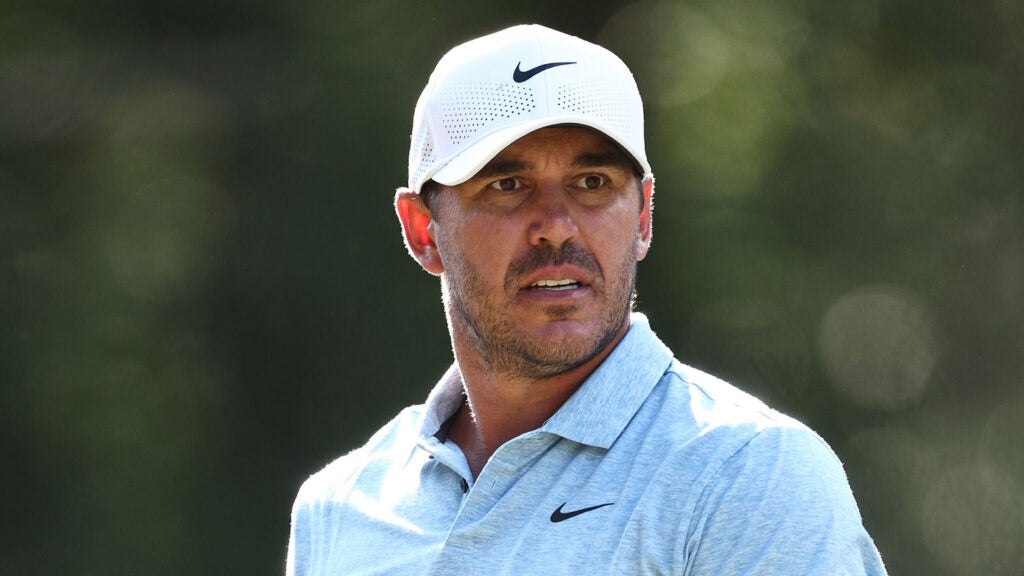PINEHURST, N.C. — In the early-going of this 124th U.S. Open, you would have been forgiven for thinking some variation of Here we go again. With three birdies and nary a blemish on his card, Brooks Koepka, just 34 and already in possession of five major titles, was doing more Brooks Koepka-at-the-majors things: smashed drives, sensible approaches, little to no conversation with his playing partners — in this case, Collin Morikawa and a badly struggling Justin Thomas. Full Terminator mode.
But then, as can happen in this most exacting of tournaments, the sweater began to unravel. Koepka’s first bogey came after a three-putt at the par-4 13th. The next after a tugged tee shot at the par-3 15th. And a third after a blocked tee shot made him play the 523-yard par-4 16th as if it were a three-shot par-5. An even-par 70 is nothing to stew about at a U.S. Open, but still, Koepka surely was thinking what could have been or, more likely, should have been. We can’t say that with certainty because afterward he declined to deconstruct his round.
After signing his card and emerging from scoring in a subterranean room just beyond the 18th green, Koepka was approached by a USGA media official who inquired if the golfer might do a short interview with NBC/Golf Channel and, after that, on-site reporters.
“Nah, I’m all right,” Koepka said.
When the official gently pleaded, Koepka’s agent, Blake Smith, took over: “He said no.”
No tournament silences players quite like the U.S. Open. One moment you’re in a par groove and flirting with the lead, the next you’re hitting the wrong side of a turtleback green and staring down a 10-footer for bogey. Koepka knows the deal. He’s playing in his 11th Open this week. In his previous 10, all he’s done is win two and finish top-5 in two more. His physical tools are one thing, but when he’s at his world-beating best, the asset that most separates Koepka is his mental strength. That, and the self-confidence to believe that he’s flat-out better than just about all of his opponents. He laid out the formula for us back at the 2019 PGA Championship at Bethpage Black, five days before he won that week:
“There’s 156 [players] in the field, so you figure at least 80 of them I’m just going to beat. You figure about half of them won’t play well from there, so you’re down to about maybe 35. And then from 35, some of them just — pressure is going to get to them. It only leaves you with a few more, and you’ve just got to beat those guys.”
That’s not cockiness. Well, maybe it is. But all the greats think that way at the majors. Nicklaus most certainly did. Tiger, of course. Ask the last guy to win a U.S. Open on this Mensa exam disguised as a golf course.
“This week, maybe 50 percent of the field don’t believe in themselves that they can do well here because it is a scary track,” Martin Kaymer, the runaway champion in 2014, said Tuesday. “As I said to my caddie earlier, mentally it’s such a funny approach this week because usually you go on to the putting green and you try to make birdie, you try to make the putt. Here, it almost creeps in that you want to avoid the bogey, avoid the three-putt, because a lot can happen. This is a strange thought. This is a new thought.
“I talked to a few players, and a bunch of them, they have their thought: avoiding the bad. I think great players, they have that positivity and that belief every single course they play. They don’t have that doubt.”
If you’re a 15-handicapper who often needs three putts to get home or two swipes to escape a bunker, what Kaymer is describing is not at all a foreign concept but rather a familiar one. But to the world’s best players, defense is not a strategy they frequently elect to exercise. Sure, it’s in the playbook but on page 417.
“If you miss it short side, it’s an auto bogey or higher,” Tiger Woods said after his opening six-bogey 74 likely dashed his hopes of weekend tee times. “Being aggressive to a conservative line is I think how you need to play this particular golf course.”
On Thursday morning, Tony Finau got aggressive on an aggressive line: hitting a beautiful, swooping 5-iron at the par-3 6th that he would later call his best shot of the day. The ball touched down 10 yards short of the hole, scooted just past the cup and then kept rolling…and rolling…and buh-bye, off the green. Just to be clear: Finau’s self-described best shot of the day missed the green.
“The greens are right where they want ’em,” Woods said. “A lot of the pins were right up on the crest of the green. If you dumped the ball in the middle of the green, it was into the grain then down grain.” (Translation: slower then faster.) “That’s how the golf course is going to be set up. We know that going in here. Just a matter of putting the ball in correct spots and just making a bunch of pars and occasionally a birdie here and there, it can be done.”
Done or undone. At U.S. Opens, there isn’t much in between.
“I knew every hole out here is so tough,” said Morikawa, who made a pair of double bogeys but also a pair of closing birdies to scratch back to even for the day. “If I let it affect me, then you might as well just call it over and just kind of walk it on in.”
Strange thoughts, indeed.
